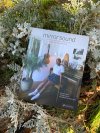
“Spencer often leads his artist interviews by asking about their earliest experience self-recording. The writing throughout Mirror Sound is so contemplative that my own answer automatically surfaces; my sister and me, very young on the floor of her room playing with a tape deck.”
Mirror Sound, created by writer/musician Spencer Tweedy, graphic designer Lawrence Azerrad, and photographer Daniel Topete, is a visually stunning meditation on the joys, complications, and idiosyncrasies of recording one’s own music. 24-year-old Spencer, who has been self-recording since high school, reflects on his own experiences and weaves in insights, observations, and anecdotes from 27 fellow self-recording artists. The wide-ranging spectrum of interviewees includes recording trailblazers such as Suzanne Ciani and Emitt Rhodes, as well as his own peers such as Vagabon, Jay Som, and Frankie Cosmos.
Artistic freedom shines through as the underlying motivation behind more and more artists recording their own music. Melding the processes of writing, performing, and engineering all into one, self-recording allows musicians to explore their abilities further than they might in a recording studio with professional engineers. Merrill Garbus of Tune-Yards, multi-instrumentalist Yuka Honda, and even Spencer’s father Jeff Tweedy, frontman of Wilco, all describe instances in which they’ve shrunken away from a creative vision in an established recording setting because of skewed power dynamics in the industry.

Photo by Alex Berner-Coe
When creating on their own time and in their own spaces, self-recording artists find comfort in taking as much time as they need and experimenting along the way. Without the excessive influence of others, they lead with intuition over sensibility. They allow a wider spectrum of sounds into their music — random noises that would never penetrate the walls of a sound-proofed studio — and they feel a deeper connection with what they make. Baked-in imperfections, the physical constraints of their set-ups, and unexpected collaborators, like chatty roommates or a barking dog, afford self-recording musicians a layer of nuance and individuality that isn’t found in many high-fidelity recordings.
Spencer’s insights, paired with Daniel Topete’s breathtaking photos of living rooms, garages, and cars that have been transformed into recording spaces, nudge us away from the notion that creative pursuits are only for a select few with specific access. Mirror Sound’s overarching thesis is that anyone with a recording mechanism can make a record, and there’s no right or wrong way. All self-recorded music, or any recording for that matter, reflects the confluence of many circumstances: the size of the space, what else is in it, endless combinations of your own conscious and unconscious decisions. To use Spencer’s exact words, the beauty lies in the fact that the result is something only you can make.
Spencer often leads his artist interviews by asking about their earliest experience self-recording. The writing throughout Mirror Sound is so contemplative that my own answer automatically surfaces; my sister and me, very young on the floor of her room playing with a tape deck. My dad had made us a James Taylor mixtape, and we began to record our own voices over the music, until the tape was entirely interspersed with messy cuts, our exuberant singing, us chatting and playing. We knew we were ruining the tape, but there was almost an instinctual pull towards documenting ourselves, an instant exhilaration that hinged on pressing RECORD; the satisfyingly clear ‘before’ and ‘after.’
As this memory resurfaced, I realized gleefully that we had essentially made our own hodgepodge bedroom record as tiny children, a conclusion I would have never come to without reading Mirror Sound. The idealism of Mirror Sound is comforting in its simplicity — if you have a creative idea, you can actualize it on your terms. The process can be as intricate as Mac DeMarco’s garage recording rig, which allows him full wireless control of his computer while he sits across the room behind his drum kit — or, it can be as simple as hiding in a closet with a tape deck and ruining your dad’s mixtapes.
Mirror Sound is a book collaboration by musician and writer Spencer Tweedy, photographer Daniel Topete, and designer Lawrence Azerrad. It is available for purchase from Penguin Random House.

